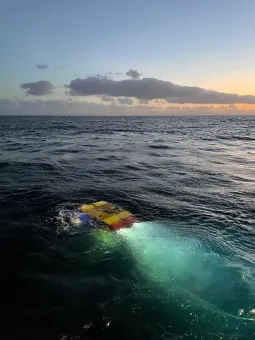
- SMARTEX is one of several NOC projects endorsed as a UN Ocean Decade Action, part of our commitment to the United Nations Sustainable Development Goals
- Learn more about this current expedition and the people on board by reading latest crew blog here
- The research expedition is enabled by the NOC operated RRS James Cook and National Marine Equipment Pool
Scientists from the National Oceanography Centre (NOC) have embarked on a month-long research expedition from Costa Rica to the Central Pacific to understand the impacts of deep-sea extraction of polymetallic nodules on the seabed. These are hard rock like materials, highly enriched in metals found on the sea floor.
The Seabed Mining And Resilience To Experimental impact (SMARTEX) project will provide the critical scientific understanding to reduce the risk of extracting these nodules in a 6 million km2 region of the central Pacific Ocean.
The polymetallic nodules are highly enriched with metals including copper, nickel, cobalt and manganese. These are important in the construction and development of sustainable technologies such as batteries, electric cars, and renewable energy devices. As such, they are highly sought after across the world. The SMARTEX project will be vital in developing understanding of the impacts of deep-sea mining and developing a safer, more sustainable way to extract these metals to protect the abyssal ecosystem. The nature of these areas is largely unknown, including its capacity to cope with and recover from wider extraction projects.
Dr Daniel Jones, Associate Head of the Ocean BioGeosciences group at the National Oceanography Centre, said: “Removing metal from the sea floor leads to a change in the structure of the seabed, its shape, and the nature of the sediments within. Understanding the impacts of extraction on these areas as well as the recovery of the environment is a critical part of SMARTEX. The way that seabed life responds to mining will be determined by understanding how mining affects the numbers, types and distribution of animals.
NOC’s SMARTEX project supports the UK Government’s Critical Minerals Strategy which listed the minerals considered of critical importance as well as the long term strategy for diversifying and improving the supply chain of these minerals. The strategy also asks important questions about whether to engage in the extraction of metals and minerals on the seabed and how to do it.
Dr Jones added: “We will provide objective information to answer the government’s critical minerals strategy. SMARTEX will investigate one of the areas sponsored by the UK and it’s our job to continue providing expert, independent advice when needed.”
The project follows a test of excavating equipment that was carried out in the late 1970’s, which lead to a large trove of data that enabled scientists to monitor disturbed areas and assess the longer-term impacts of seafloor extraction. The timescale of over 44 years makes this information even more critical to help make informed decisions on how to mine responsibly and sustainably.
Dr Jones concluded: “No one has been able look at the realistic impacts of mining over such a long period of time before. The data we will gather from monitoring in this vast area for a year will capture the variabilities that occur near the seabed and make predictions about where sediment ends up settling.”
The expeditions runs from 5 February to 26 March 2023 from Costa Rica to the Central Pacific in an area called the Clarion Clipperton Zone (CCZ) at abyssal depths of almost 5,000 metres.
Funding: Natural Environment Research Council (NERC) and its project partners. Natural History Museum, British Geological Survey, Heriot Watt University, JNCC, (Joint Nature Conservation Committee), Liverpool University, SAMS (Scottish Association of Marine Science), University of Plymouth, University of Southampton